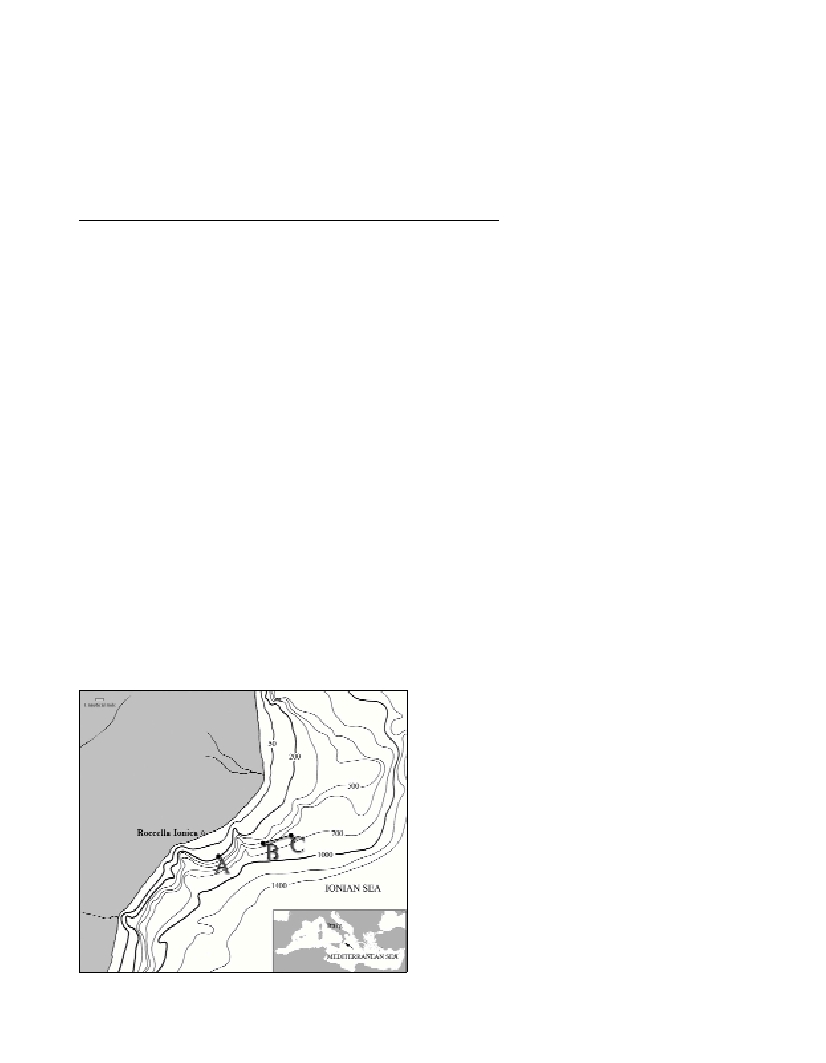RECAPTURES OF TAGGED DEEP-SEA SHRIMPS ARISTEUS ANTENNATUS(RISSO, 1816)
IN THE MEDITERRANEAN
Relini M.
1
, Maiorano P.
2*
, D’Onghia G.
2
, Orsi Relini L.
1
, Tursi A.
2
, Panza M.
2
1
Laboratorio di Biologia marina ed Ecologia animale (DIP.TE.RIS.), Università di Genova, Italy
2
Dipartimento di Zoologia, Università di Bari, Italy - * p.maiorano@biologia.uniba.it
Abstract
A tagging experiment on Aristeus antennatuswas carried out in the Ionian Sea during May 1998-September 2000. A total of 693 shrimps
were tagged and released, 23 recaptured, two of which 1 and 9 months later. A displacement of about 10 and 8 nm respectively was
recorded. A growth rate of 1 mm/month in the CL range 29-38 mm was observed in the specimen recaptured after 9 months.
Key words: Aristeus antennatus, tagging, displacement, growth, Mediterranean Sea
Rapp. Comm. int. Mer Médit., 37,2004
424
Introduction
Tagging experiments provide useful information on displacement,
growth rate and population abundance of the marine living resources
(1). Such experiments have been extensively carried out on crustacean
species living in coastal waters (2; 3) while most probably the first
case of tagging the deep water shrimp belonging to Natantia regards
the stock of Aristeus antennatus (Risso, 1816) in the Ionian Sea, along
the Calabrian coast (4; 5). One month after tagging 45 shrimps, one
female specimen was recaptured at about 10 nautical miles from the
release point. Its carapace length was unchanged. Further tagging
experiments on A. antennatus were conducted both in the Ionian and
Ligurian Sea until September 2000. As part of one of them a second
specimen was recaptured 9 months after the tagging and releasing.
New information on its displacement and growth is reported in this
note.
Material and methods
The tagging experiment was carried out in the Ionian Sea, along the
Calabrian coast, off Roccella Ionica (Fig. 1), an area where vertical
displacements of A. antennatusoccur during night hours (6).
Sampling was conducted during the night in shelf waters (150-200
m), when smaller thermic and light changes occur from water to air,
in order to reduce the impact of the capture on the specimens. A
commercial vessel equipped with an otter-trawl net with 40 mm
stretched mesh in the cod-end was hired. The catch was rapidly sorted
and all live specimens were put in a tank containing cooled sea water.
After half an hour in the tank, all swimming individuals were
measured, sexed and tagged. The tag was a green streamer 4S
HALLPRINT 95x4 mm, narrower in the middle (20x2 mm) placed
through the pleon. Each tagged specimen was replaced in the tank and
left from half an hour to two hours to allow the vessel to reach the
release site. This time lag was also useful to evaluate vitality after
tagging. Each tagged specimen was released in a segment of PVC
tube (40 cm length and 10 cm in diameter) full of water, closed and
ballasted at the lower end. The tube was gently released over-board
with the ballasted end down, so that it descended to the bottom in a
vertical position and then lay down on it, allowing the shrimp to swim
out (4). During May 1998-September 2000 a total of 693 individuals
of A. antennatuswere tagged and released in the study area.
Results and discussion
Twenty-one specimens tagged and released were recaptured shortly
after by the same vessel used for the experiment. One individual was
captured and released on 22.05.98 and recaptured after one month (4).
One specimen captured and released on 22.11.99 at 159 m depth
(38°16.76N-16°26.98E) was recaptured on 5.08.00, 9 months later,
during daylight fishing at depths between 500 and 600 m (haul
starting point 38°18.19N-16°34.00E; haul ending point 38°19.13N-
16°38.31E). This specimen was recaptured at a distance between
approximately 5.7 and 9.4 nm from the releasing point (Fig. 1). It was
a female whose size at capture and recapture were 29 and 38 mm
carapace length, respectively. The presence of spermatophores on the
thelycumwas only recorded during the recovery.
This second result confirms the feasibility of the technique for this
deep water living resource even though taking into account the high
mortality rates estimated for this species as part of stock assessment
studies, the number of tagged specimens must be large.
The present result also confirms the displacement capacity of A.
antennatusboth vertically and horizontally. Furthermore, considering
the difference in carapace length between release and recovery,
the specimen recaptured grew according to a mean growth rate of
1mm/month. This agrees with the slowest growth performance
proposed (7) based on the study of a very abundant cohort followed
for three years in Ligurian Sea. Although this pattern comes from only
one specimen, it provides the first direct measure of the growth in A.
antennatus.
References
1-Jones R., 1976. The use of marking data in fish population analysis.
FAO Fish. Tech. Pap., 153, 42 p.
2-Montgomery S.S., 1981. Tagging studies on juvenile eastern king
prawn reveal record migration. Australian Fisheries, 40 (9): 1-13.
3-Dall W., Hill B.J., Rothlisberg P.C., Staples D.J., 1990. The biology of
Penaeidae. Adv. Mar. Biol., 27: 1-489.
4-Relini M., Maiorano P., D’Onghia G., Orsi Relini L., Tursi A., Panza
M., 2000. A pilot experiment of tagging the deep shrimp Aristeus
antennatus(Risso, 1816). Sci. Mar., 64 (3): 357-361.
5-Relini M., 2000. Valutazione delle risorse biologiche rappresentate dai
gamberi di ambiente batiale, Aristeus antennatuse Aristaeomorpha
foliacea, in due bacini mediterranei. PhD Thesis. University of Bari,
255p.
6-Matarrese A., D’Onghia G., De Florio M., Panza M., Costantino G.,
1995. Recenti acquisizioni sulla distribuzione batimetrica di
Aristaeomorpha foliaceaed Aristeus antennatus(Crustacea, Decapoda)
nel Mar Ionio. Biol. Mar. Medit.,2(2): 299-300.
7-Orsi Relini L., Relini G., 1998. Seventeen instars of adult life in
females of Aristeus antennatus(Decapoda Aristeidae). A new
interpretation of life span and growth. J. Nat. Hist., 32: 1719-1734.
Fig. 1. Release point and area of recapture (haul route) of the specimen
caught after 9 months.

